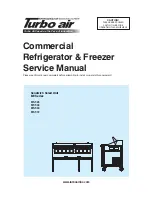
62
TK 56433-5-MM-EN
check valve as follows:
1.
Remove the condenser pressure bypass check
valve cap from the three-way valve.
2.
Using a screwdriver, gently turn the check valve
stem in until the valve is front seated.
3.
Install a gauge manifold set on the compressor.
4.
Close (front seat) the receiver tank outlet valve.
Figure 71.
Three-way Valve Condenser Pressure
Bypass Check Valve
1.
Check Valve
2.
Heating/Defrost Position
3.
Cooling Position
5.
Operate the unit on cool and pump down the low
side to 20 in. Hg (-68 kPa)of vacuum.
6.
Stop the unit. The condenser and suction pressures
should remain stable, indicating no leaks.
7.
Shift the three-way valve to the heat position. The
low side gauge will raise slightly. The high side
gauge will drop to approximately zero. The gauges
will equalize.
8.
The gauges will remain in this position,
approximately zero, if the three-way valve seals
properly toward the condenser and the condenser
pressure bypass check valve seals properly.
9.
Back seat condenser pressure bypass check valve
stem against the snap ring. Both gauges should rise
indicating the condenser pressure bypass check
valve is properly releasing condenser pressure into
the discharge tube and evaporator.
10. Replace the cap on the condenser pressure bypass
check valve.
N
No
otte
e:: Valve stem MUST be back seated during
normal unit operation.
11. Open the receiver tank return outlet valve, remove
the gauges and return the unit to normal operation.
Electronic Throttling Valve (ETV)
The Electronic Throttling Valve (ETV) is standard on the
these units. The ETV is a variable position valve
operated by a stepper motor. The ETV is located in the
suction line between the accumulator and the suction
vibrasorber. The ETV system also uses discharge and
suction pressure transducers, and a hot gas bypass
valve.
The ETV has two internal coils. The microprocessor
operates the valve by energizing the coils with a
variable frequency AC signal. The valve position can be
monitored with the Gauges Menu. Zero (0) indicates
the valve is fully closed and 800 indicates the valve is
fully open.
The microprocessor tests the ETV if required when the
unit is started. Alarm Code 89 indicates the
refrigeration system pressures did not respond as
expected during the test. This may be caused by a
malfunction of the ETV or by a refrigeration system
problem such as low refrigerant level, a frozen
expansion valve, or a restriction in suction line. The
microprocessor ignores the test results if the box
temperature or the ambient temperature is below 10 F
(-12 C). The ETV test can also be performed using the
Service Test Mode.
Use the Gauges Menu to observe the ETV position
during the ETV test. The expected ETV position
observation is a decrease followed by an increase. The
suction pressure should decrease when the valve
position decreases and increase when the valve
position increases.
Refer to the appropriate Diagnostic Manual for
complete information about the testing and operation
of the ETV.
Refer to “Electronic Throttling Valve” in Refrigeration
Service Operations for removal and installation
procedures.
















































